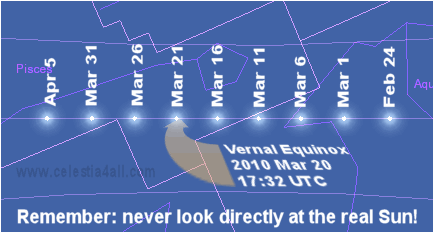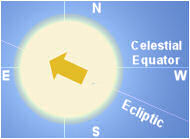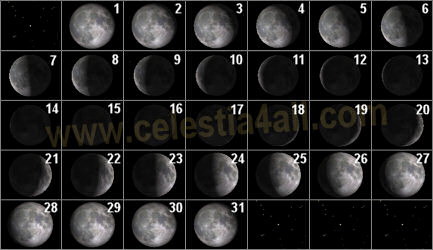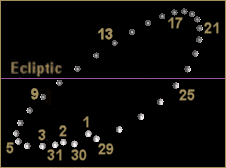








AVAILABLE MONTHS
2010:
Jan
Feb
Mar
Apr
May
Jun
Jul
Aug
Sep
Oct
Nov
Dec
2011:
Jan
Feb
Mar
Apr
May
Jun
APPARENT PATHS OF THE PLANETS
This month, Mars finishes its retrograde motion, although Saturn does not.

MERCURY & VENUS: 2010 Mar
Speedy as always, Mercury and Venus "follow" the Sun, both Inferior Planets moving eastward throughout March. Traversing Aquarius almost entirely before achieving Superior Conjunction in mid-March, Mercury then grazes Cetus and almost completely crosses Pisces by month's end. Ready to exit Aquarius as March begins, Venus enters Pices, grazes Cetus, and then exits Pisces by the end of the month (1.6.x) (1.4.1).
MARS: 2010 Mar
Its retrograde or westward motion (toward the right on your screen) in Cancer having noticeably slowed at the end of February, Mars again starts moving eastward in the middle of March (1.6.x) (1.4.1). Because its orbit is relatively similar in size to Earth's orbit, Mars will not "go retrograde" again until early 2012.
Here again are last month's links that let you see Mars's entire retrograde loop of 2009-2010 (1.6.x) (1.4.1)
JUPITER, URANUS & NEPTUNE: 2010 Mar
In conjunction (i.e. been "overtaken" by the Sun) on the last day of February, Jupiter continues to move slowly through Aquarius in March. Mercury passes "under" it on the 8th, and the Moon "flies high over" it at mid-month (1.6.x) (1.4.1)
Uranus never leaves Pisces, though Neptune manages to exit Capricornus and enter Aquarius by the end of the month.
SATURN: 2010 Mar
Slow-moving, distant Saturn continues its retrograde motion in Virgo throughout the entire month of March and achieves opposition on the 22nd. The Moon, nearly-full as it passes both at the beginning and the end of the month, is the only other major Solar System object that we see near Saturn throughout March (1.6.x) (1.4.1)
Here again are last month's links that let you see Saturn's entire (though smallish) retrograde loop of 2010 (1.6.x) (1.4.1)
CELES-TIPS
The following will help you enjoy this page's many links that run events directly in CELESTIA. If you're new to the program, these tips will also help you learn to use it.
- If CELESTIA's clock (i.e. the program's date and time) is not visible at the top right of its window, press the V key until you see it. This will also turn on information text in other corners as well. This text will help you keep track of several aspects of the event you're viewing.
- Pressing the "un-shifted" L key and K key respectively will speed up and slow down CELESTIA's flow of time by a factor of 10 in version 1.6.x and 1.4.1.
- Pressing Shift+L and Shift+K respectively will speed up and slow down CELESTIA's flow of time by a factor of 2 in version 1.6.x only.
- Pressing the J key (either shifted or "un-shifted") will reverse CELESTIA's flow of time in version 1.6.x and 1.4.1.
You'll find more information about many of CELESTIA's controls on our Learning Center page.
CLIMATIC VS. ASTRONOMICAL SEASONS
Most school children know that the climatic seasons of the two hemispheres are the reverse of each other's. For example, when it is Summer in the Northern Hemisphere, it is Winter in the Southern Hemisphere, etc.
Of course, traditionally the "astronomical" seasons are named for the "climatic" ones of the Northern Hemisphere, which unfortunately creates an ambiguity. For example, for Southern Hemisphere astronomers, the Summer Solstice occurs at the start of their climatic Winter!
This is why we increasingly see the less traditional (and slightly less recognizable) terms: March Equinox, June Solstice, September Equinox and December Solstice. Because these terms are more precise, they are increasingly becoming accepted as the best ways to refer to the equinoxes and solstices.
HIGHLIGHT EVENT
JUPITER DOUBLE & MUTUAL SOLAR ECLIPSE 2010 March 31
To view this video in a larger size, click here.
THE SUN
APPARENT PATH OF THE SUN: 2010 Mar
Here are the Sun's positions along the Ecliptic at 00:00 UTC on the days shown.

The slightly curved lines above and below the Ecliptic show the extent of the Zodiac, which you may download from our Bonuses page and add to any version of CELESTIA. Note that the curve in the Zodiac lines is the result of CELESTIA's rendering in perspective.
 W A R N I N G ! It is never safe to look directly at the real Sun with the naked eye! Moreover, looking at it through a telescope or binoculars—even for an instant—can cause permanent blindness! NEVER DO IT! Consult the professionals at your local planetarium or observatory to learn how you can safely "observe" the Sun and any SOLAR eclipse!
W A R N I N G ! It is never safe to look directly at the real Sun with the naked eye! Moreover, looking at it through a telescope or binoculars—even for an instant—can cause permanent blindness! NEVER DO IT! Consult the professionals at your local planetarium or observatory to learn how you can safely "observe" the Sun and any SOLAR eclipse!
Of course, you can safely view CELESTIA's depiction of the Sun's apparent path in the sky in March. Here are the links: (1.6.x) (1.4.1). Note that versions 1.6.x and 1.4.1 differ in the way their "follow" and "lock" features work. If you "follow" Earth and then "lock" the Sun to it, versions 1.6.x and 1.4.1 respectively maintain the "attitudes" of the Ecliptic and the the Celestial Equator. This means that the Ecliptic remains "level" when you run the first link, but begins to tilt when you run the second! Differences like this will be discussed on our Help page.
HALF OF EARTH IN SUNLIGHT & DARKNESS
During your voyages in CELESTIA, would you like to be able to position yourself directly over the center of the half of Earth in sunlight or the half in darkness at any time this month? On our Tips page, you'll find that it's quite easy to do so! If you're any kind of sky watcher at all, you probably know just how helpful this can be!
VERNAL EQUINOX: 2010
The ancients recognized that day and night are most equal in length at two specific times of year. They called these times "equinoxes", which means "equal night". Equinoxes occur at the two times each year when the Sun—in its "apparent" motion in our skies—crosses the Celestial Equator.
In modern times, the term "equinoxes" has broadened to include at least two additional meanings—both denoting "locations" instead of times. First, the term can also mean the "points" in the sky where the above-mentioned crossings appear to occur. Second, it can mean the two "points" in the sky—at "any" instant—where the Ecliptic and the Celestial Equator intersect. This last definition is what is meant when we speak of an "equinox of date."
 In its meaning as a "time", the Vernal (or Spring) Equinox is important, as it is the moment the Sun's center appears to move north of the Celestial Equator. This usually occurs on March 20 or 21 and marks the first instant of Spring. As noted in the "Apparent Path of the Sun" image near the top of this page, the 2010 Vernal Equinox occurs on March 20 at 17:32 UTC.
In its meaning as a "time", the Vernal (or Spring) Equinox is important, as it is the moment the Sun's center appears to move north of the Celestial Equator. This usually occurs on March 20 or 21 and marks the first instant of Spring. As noted in the "Apparent Path of the Sun" image near the top of this page, the 2010 Vernal Equinox occurs on March 20 at 17:32 UTC.
The "point" (location) where the Sun's center appears to move north of the Celestial Equator, the Vernal Equinox "point", is very important to astronomers too. It provides an "origin" or "starting point," on the background of stars, from which they can "map" the sky with a system similar to Longitude and Latitude. Astronomers call the sky coordinates of this system "Right Ascension" and "Declination", and their respective values at the Vernal Equinox "point" are 0 hr, 0°.
Now, users should be aware that CELESTIA will not show the Sun crossing the program's Celestial Equator at the times generally published for equinoxes. This is because it draws the Celestial Sphere for the J2000 epoch, not a constantly updated one for any "equinox of date." We should therefore expect CELESTIA to most accurately show the time of the Sun's crossing of the Celestial Equator for the year 2000 CE, and less and less accurately the farther you get from that year. And this is indeed the case. Thus, in the following views of the 2000 Vernal Equinox, we see the Sun's center ascend through the Celestial Equator at very near the theoretically correct time of 7:35 UT (1.6.x) (1.4.1). Conversely, the following views of 2010 show the Sun's center crossing the Celestial Equator considerably later than the predicted 17:32 UT (1.6.x) (1.4.1). We stress that this is not a bug or an error. It is rather a simplification or "streamlining" not unlike astronomers referring sky-object positions to the J2000 epoch.
Don't worry if you don't fully understand the previous few paragraphs. Our "Unlocking CELESTIAL Secrets" feature will soon contain more detailed yet clear and understandable explanations of equinoxes, epochs, coordinate systems and much more. Soon, you may be the one explaining these intriguing and useful concepts to your friends.
THE MOON
PHASES OF THE MOON: 2010 Mar
In UTC per CELESTIA 1.6.x (& 1.4.1):
3rd Qtr: Mar 7, 15:43 (15:44). New: Mar 15, 21:02 (21:03).
1st Qtr: Mar 23, 11:01 (11:02). Full: Mar 30, 2:26 (2:27).
NOTE: New, 1st Quarter, Full and 3rd Quarter Moons respectively are defined to occur when the Geocentric Ecliptic Longitudes of the Moon and the Sun differ by 0°, 90°, 180° and 270°.

Produced with our "Moon Phase Calendar" script. The numbers of the days of the month were added with an image-editing program.
LUNAR PERIGEE & APOGEE: 2010 Mar
Per CELESTIA 1.6.x (and 1.4.1):
Apogee: Mar 12 10:02 (10:03) UTC; 406,013 km.
Perigee: Mar 28 4:52 (4:53) UTC; 361,871 km.
Determined by our "Earth-Moon Distance" and "Moon's Apparent Path" scripts. Note that distances given are the distances between Earth's and the Moon's centers.
LUNAR ANALEMMA: 2010 Mar
Here is the lunar analemma, generated by the Moon's positions relative to the mean lunar orbit and the Ecliptic at 0:00 UTC every day of March.

This phenomenon can be observed using our "Moon's Apparent Path" script. Compared to the previous two months, the lunar analemma now appears to be widening into a clockwise oval. Its change of shape month after month begins to give us an idea of just how irregular the lunar orbit is.
ASTRONOMICAL SEASONS
In this month of the Vernal Equinox, it is appropriate to make the following points regarding the seasons. Since their beginnings and ends are explicitly defined by the Sun's arrival at the equinoxes and the solstices, Earth's astronomical seasons have precise durations. Moreover, though the equinoxes and solstices are equally spaced at 90-degree intervals around the Celestial Sphere, the astronomical seasons are not of equal length! This is because Earth's changing velocity in its elliptical orbit makes the Sun appear to arrive a little early at parts of the Celestial Sphere, and a little late at others.
The lengths of the astronomical seasons are very close to the following: Spring: 92 3/4 days; Summer: 93 2/3 days; Autumn: 89 5/6 days and Winter: 89 days. You can verify these durations quite easily in CELESTIA. As the Sun makes its yearly journey around our sky, just take note of when its center crosses the following hours of Right Ascension: 0 hr (Vernal Equinox) (1.6.x) (1.4.1); 6 hr (Summer Solstice) (1.6.x) (1.4.1); 12 hr (Autumnal Equinox) (1.6.x) (1.4.1); 18 hr (Winter Solstice) (1.6.x) (1.4.1); and 0 hr (next Vernal Equinox) (1.6.x) (1.4.1).
We'll let you do the math for the time being, but very soon our free CELES-TIMER tool will make it easy for you. You can also verify that any Winter and the very next Spring always begin at nearly the same time of day.
Since Earth travels a quarter of the way around the sky during each season, and since it does so in the shortest time in Winter, this also must be when it is traveling its fastest in its orbit. In fact, Earth's velocity is nearly 3,600 km/h higher in early January (at its maximum) than in early July (at its minimum.) No doubt, many of you have already deduced the connection here, that the lengths of the astronomical seasons turn out to be a confirmation of Kepler's Laws! Why? Kepler's Laws tell us that Earth travels fastest when it is closest to the Sun. And, as we saw in our News page for January, that is the month when Earth is indeed at perihelion!
One final note: we often make the mistake of thinking that the seasons are unchanging. But, like nearly everything else in astronomy, the seasons too constantly (though gradually) vary. This is due to the many cycles of Earth's inclination, rotation and orbit. For example, during the dynasty of the Great Pyramid, Autumn was the shortest "astronomical" season, while Spring was the longest!
Donate safely with: PayPal
to receive one or more
Sky-Gifts. Your support is greatly appreciated!
Various astronomical "shadow events" occur throughout the Solar System! This month's more interesting ones are featured here.
SHADOW WORKS
Here we highlight (and set up) the most awe-inspiring eclipses taking place in our Solar System, so that all you need to do is click on their links. Don't forget that you can generate lists of Earth's, Jupiter's, Saturn's, Uranus's, Neptune's and even Pluto's eclipses, using CELESTIA's own built-in "Eclipse Finder." You'll find it in the program's menu under "Navigation".
All events listed below are displayed as if viewed from Earth, their magnifications shown in parentheses at the lower right of CELESTIA's window. Events involving more than one moon are often cyclical, so usually only the first example is given, and then the period of the cycle.
 JUPITER
JUPITER
As depicted in CELESTIA, here are highlights of the 34 solar eclipses that Io, Europa, Ganymede and Callisto—the "Galilean" moons of Jupiter—produce in March. You'll see simultaneous solar eclipses this month, as two Galileans cast their shadows on Jupiter at the same time. Moreover, you'll see "mutual eclipses" too, i.e. when one moon casts its shadow on another moon! As always, examples of the Galilean moons moving into Jupiter's shadow are also included.
- Mar 1: Ganymede casts its shadow on Jupiter and then passes Europa, which moves behind Jupiter just after disappearing into its shadow; nearly the same will repeat about every 7 days 4 hours; (note: since Jupiter was in conjunction on February 28, its shadow is now seen increasingly to the west (the right) of it (1.6.x) (1.4.1)
- Mar 3: as we saw last month, Europa casts its shadow on Jupiter, followed by Io which is slowly "catching up" in a cycle that repeats about every 3½ days; (1.6.x) (1.4.1); in fact, here they just manage to produce—at Jupiter's terminators—simultaneous solar eclipses that will become more pronounced with each repitition in the 3½-day cycle! (1.6.x) (1.4.1) (Right Drag and you'll see half Europa's shadow on one terminator and half of Io's on the other.)
- Mar 5: Ganymede moves into shadow and behind Jupiter and emerges before Europa does the same; but Io appears to cast its shadow on Jupiter before Europa emerges; because this involves the same three moons as the March 1 event, this too repeats in about a 7-day-4-hour cycle (1.6.x) (1.4.1)
- Mar 6: Io moves into shadow and behind Jupiter and emerges, and then Callisto does the same (1.6.x) (1.4.1)
- Mar 7: here events of the March 3 cycle repeat with more noticeable simultaneous solar eclipses (1.6.x) (1.4.1)
- Mar 14: Callisto, the most distant Galilean moon from Jupiter, casts its shadow, then Io moves into shadow and behind Jupiter (1.6.x) (1.4.1); (and don't forget to check earlier on this date for a repitition of events in a cycle mentioned above!)
- Mar 21: this can't pass without a note: as the March 3 cycle continues, Io's shadow and then Io itself both pass beneath Europa! (so, from our vantage point, Europa eclipses both Io and its shadow!) (1.6.x) (1.4.1); keep an eye on this 3½-day cycle.
- Mar 22: as the March 1 cycle has continued, Io has overtaken Ganymede as it casts its shadow on Jupiter, the two moons producing simultaneous solar eclipses; meanwhile Europa having moved into shadow and behind Jupiter, then emerges (1.6.x) (1.4.1); with a wider Field of View, we discover that, as this all is ending, Callisto enters Jupiter's shadow! (1.6.x) (1.4.1)
- Mar 24: the March 3 cycle intrigues us yet again as Europa's and Io's shadows are again cast on Jupiter at the same time; but then Europa casts its shadow on Io itself in a stunning "mutual eclipse" (that is, when a moon casts its shadow on aother moon!) (1.6.x) (1.4.1); here's a closer look with time slowed down (1.6.x) (1.4.1)
- Mar 28: as part of the continiung March 3 cycle, Europa casts its shadow on Io in another mutual eclipse that appears near the center of Jupiter (1.6.x) (1.4.1); here's a closer look with time slowed down (1.6.x) (1.4.1)
- Mar 30: Europa disappears into shadow and behind Jupiter, at nearly the time Io and Ganymede produce simultaneous solar eclipses (1.6.x) (1.4.1)
- Mar 31: Callisto casts its shadow on Jupiter before the March 3 cycle intrigues us again; as Europa casts its shadow on Io in another mutual eclipse, a shadow appears on Jupiter—only to "split" in two! (1.6.x) (1.4.1); here's a closer look with time slowed down (1.6.x) (1.4.1); (you can also see these Europa and Io eclipses in our Highlight Event video at the top of this page)
 SATURN
SATURN
While CELESTIA 1.6.x shows the shadows of Titan, Rhea, Iapetus, Dione and Tethys, version 1.4.1 displays only the shadows of Titan, Rhea & Iapetus. So, 1.6.x and 1.4.1 respectively show 35 and 6 solar eclipses on Saturn in March. The highlights are as follows:
- Mar 1: Tethys and Dione produce simultaneous solar eclipses; Tethys currently casts its shadow on Saturn almost every 2 days; Dione currently does so about every 2¾ days (1.6.x only)
- Mar 3-4: as Dione casts its shadow on Saturn, Tethys moves into Saturn's shadow (1.6.x only)
- Mar 5: Rhea casts its shadow on Saturn, as it currently does about every 4½ days; then Dione moves into Saturn's shadow (1.6.x) (1.4.1)
- Mar 6: as Dione and then Tethys cast their shadows on Saturn, distant Titan moves "above" Saturn's shadow (1.6.x only)
- Mar 23: Dione and Rhea produce simultaneous solar eclipses for just 2 minutes; note how they are almost directly in front of their shadows because Saturn is so near its opposition (Mar 22) (1.6.x only)
- Mar 25: Tethys and Dione casts their shadows on Saturn at the same time (1.6.x only)
- Mar 31: this time Dione casts its shadow on Saturn first and then Tethys to produce simultaneous solar eclipses (1.6.x only)
URANUS, NEPTUNE & Dwarf Planet PLUTO
Neither Uranus nor Neptune will experience eclipses for decades. Dwarf planet Pluto will experience no eclipses by Charon for about a century!
Back to Top
Home Intro News Gallery Sky-Gifts Bonuses Tips
Learning Ctr Help Links Credits Legal Contact Us
© 2007-
by Gary M. Winter. All rights reserved.
Interested in political cartoons and humor?
Check out The HIPPLOMATS™.
SkyMarvels, SkyMarvels: Your Key to the Sky and the Universe! Sky Marvels, SkyMarvels.com, celestia4all, celestiaforall, CELESTIA, astronomy, space, simulations, animations, downloadable astronomy posters, stars, planets, Inner Planets, Outer Planets, Inferior Planets, Superior Planets, moons, asteroids, comets, Oort Cloud, galaxy, galaxies, Milky Way, Andromeda, globular clusters, binaries, quasars, black holes, supermassive black holes, telescope, telescopes, planetarium, software, freestuff, satellites, add-ons, addons, scripts, eclipses, Solar Eclipses, Lunar Eclipses, Solar Eclipse Finder, Lunar Eclipse Finder, mutual eclipses, transits, occultations, Solar System, CELES-TOOLS, celeSTARrium, CELX, CELX programming, Freebies, Bonuses, multiple views, atronomical unit, light year, parsec, meteors, meteor showers, Perseids, Geminids, Leonids, barycenter, time, Time Zones, tides, alignments, conjunctions, oppositions, seasons, apogees, perigees, aphelion, perihelion, Earth, Luna, Mercury, Venus, Mars, Jupiter, Galilean Moons, Io, Europa, Ganymede, Callisto, Saturn, Titan, rings, Uranus, Neptune, Triton, E-MSpectrum, electromagnetic spectrum, astronaut, equinoxes, solstices, precession, rotation, spin, inclination, tilt, Ecliptic, orbits, ellipse, parabola, hyperbola












